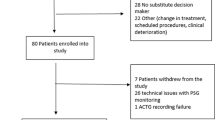Abstract
Objective
The objective of this study was to determine what impact the omission of respiratory events scored during wake epochs has on the generation of the apnea/hypopnea index (AHI) using computerised polysomnography (PSG).
Materials and methods
Sixty diagnostic PSG recordings were scored using the recommended method of sleep staging with epochs. In addition, absolute sleep scoring criteria was used to calculate the total sleep time (TST). The TST, respiratory events and AHI generated from both scoring methods were compared.
Results
The AHI from epoch scoring (AHIEP) was significantly less than that derived from absolute sleep staging (AHIABS) [AHIEP = 15.8 events/hour (7.3, 38.2), AHIABS = 18.8 events/hour (8.7, 40.2); p < 0.0001]. From a total of 8,820 legitimately scored respiratory events ≥10 s duration, 723 (8%) were excluded from the AHIEP calculation as they were identified as having occurred during wake, but 400 of these (57%) started in an epoch of wake and continued into epoch(s) of sleep. These omitted events were not trivial [median 16.6 s (13.0, 24.0)] and were frequently associated with oxygen desaturation events [median 4% (3.0, 7.0)] with a range of 3% to 39%.
Conclusion
The use of arbitrarily defined epochs for sleep staging has a direct impact on legitimately scored respiratory events resulting in the systematically incorrect reporting of the AHI. This artefact is due to computerised data reduction excluding all respiratory events that are contained within an epoch(s) of wake as well as those that start in an epoch scored as wake.






Similar content being viewed by others
References
Loomis AL, Harvey EN, Hobart GA (1938) Distribution of disturbance patterns in the human electroencephalogram, with special reference to sleep. J Neurophysiol 1:413–430
Bonnet M, Carley D, Carskadon MA, Easton P, Guilleminault C, Harper R, Hayes B, Hirshkowitz M, Ktonas P, Keenan S, Pressman M, Roehrs T, Smith J, Walsh J, Weber S, Westbrook P (1992) EEG arousals: scoring rules and examples: a preliminary report from the Sleep Disorders Atlas Task Force of the American Sleep Disorders Association. Sleep 15(2):173–184
Rechtschaffen A, Kales A (1968) A manual of standardized terminology, techniques, and scoring system for sleep stages of human subjects. National Institute of Health Publication 204: US Government Printing Office, Washington DC
The Report of an American Academy of Sleep Medicine Task Force (1999) Sleep-related breathing disorders in adults: recommendations for syndrome definition and measurement techniques in clinical research. Sleep 22(5):667–689
Silber MH, Ancoli-Israel S, Bonnet MH, Chokroverty S, Grigg-Damberger MM, Hirshkowitz M, Kapen S, Keenan SA, Kryger MH, Penzel T, Pressman MR, Iber C (2007) The visual scoring of sleep in adults. J Clin Sleep Med 3(2):121–131
Bonnet MH, Doghramji K, Roehrs T, Stepanski EJ, Sheldon SH, Walters AS, Wise M, Chesson AL (2007) The scoring of arousal in sleep: reliability, validity, and alternatives. J Clin Sleep Med 3(2):133–145
Redline S, Budhiraja R, Kapur V, Marcus CL, Mateika JH, Mehra R, Parthasarthy S, Somers VK, Strohl KP, Sulit LG, Gozal D, Wise MS, Quan SF (2007) The scoring of respiratory events in sleep: reliability and validity. J Clin Sleep Med 3(2):169–200
Iber C, Ancoli-Israel S, Chesson A, Quan SF (eds) (2007) The AASM manual for the scoring of sleep and associated events: rules, terminology and technical specifications. American Academy of Sleep Medicine, Westchester IL
Norman RG, Pal I, Stewart C, Walsleben JA, Rapoport DM (2000) Interobserver agreement among sleep scorers from different centers in a large dataset. Sleep 23(7):901–908
Praetorius HM, Bodenstein G, Creutzfeldt OD (1977) Adaptive segmentation of EEG records: a new approach to automatic EEG analysis. Electroencephalogr Clin Neurophysiol 42(1):84–94
American Academy of Sleep Medicine (2010) FAQs scoring manual. American Academy of Sleep Medicine. http://www.aasmnet.org/FAQs.aspx?cid=29. Accessed 30 January 2010
Bloch KE (1997) Polysomnography: a systematic review. Technol Health Care 5(4):285–305
Bennett LS, Langford BA, Stradling JR, Davies RJ (1998) Sleep fragmentation indices as predictors of daytime sleepiness and nCPAP response in obstructive sleep apnea. Am J Respir Crit Care Med 158(3):778–786
McGregor P, Thorpy MJ, Schmidt-Nowara WW, Ledereich PS, Snyder M (1992) T-sleep: an improved method for scoring breathing-disordered sleep. Sleep 15(4):359–363
White DP, Gibb TJ (1998) Evaluation of a computerized polysomnographic system. Sleep 21(2):188–196
Biernacka H, Douglas NJ (1993) Evaluation of a computerised polysomnography system. Thorax 48(3):280–283
Andreas S, von Breska B, Magnusson K, Kreuzer H (1993) Validation of automated sleep stage and apnoea analysis in suspected obstructive sleep apnoea. Eur Respir J 6(1):48–52
Bliwise D, Bliwise NG, Kraemer HC, Dement W (1984) Measurement error in visually scored electrophysiological data: respiration during sleep. J Neurosci Methods 12(1):49–56
Marcus CL, Omlin KJ, Basinki DJ, Bailey SL, Rachal AB, Von Pechmann WS, Keens TG, Ward SL (1992) Normal polysomnographic values for children and adolescents. Am Rev Respir Dis 146:1235–1239
Acknowledgements
The authors would like to thank the staff in the sleep laboratory at North Gosford Private Hospital for setting up and supervising the laboratory-based PSG recordings and Prof. Jennifer Peat for advice regarding statistical analysis.
Conflict of interest
The authors declare that they have no conflict of interest.
Author information
Authors and Affiliations
Corresponding author
Rights and permissions
About this article
Cite this article
Norman, M.B., Middleton, S. & Sullivan, C.E. The use of epochs to stage sleep results in incorrect computer-generated AHI values. Sleep Breath 15, 385–392 (2011). https://doi.org/10.1007/s11325-010-0344-5
Received:
Revised:
Accepted:
Published:
Issue Date:
DOI: https://doi.org/10.1007/s11325-010-0344-5




